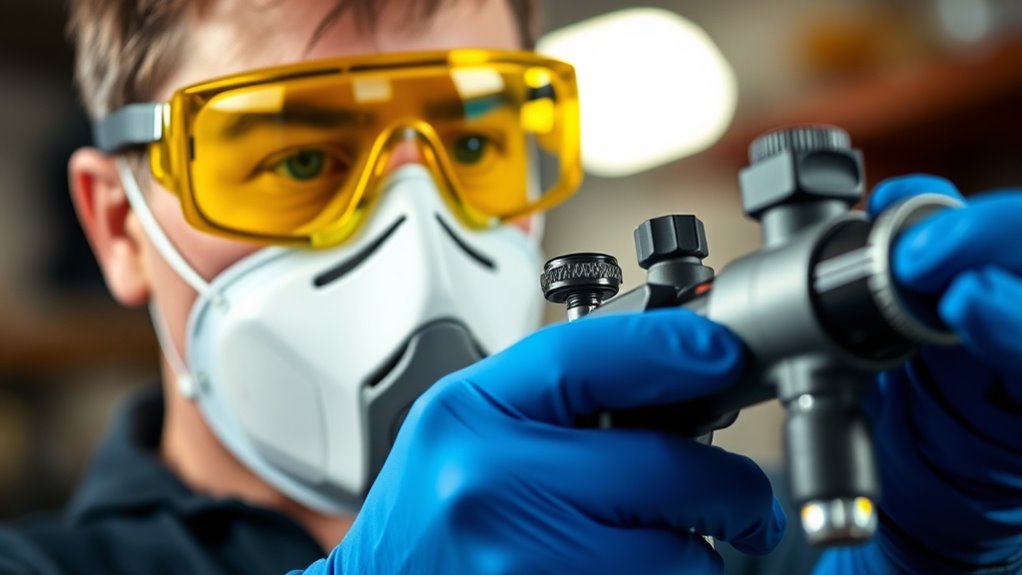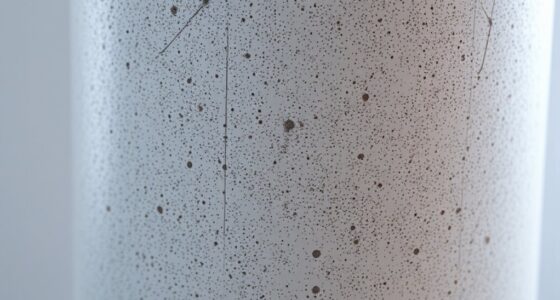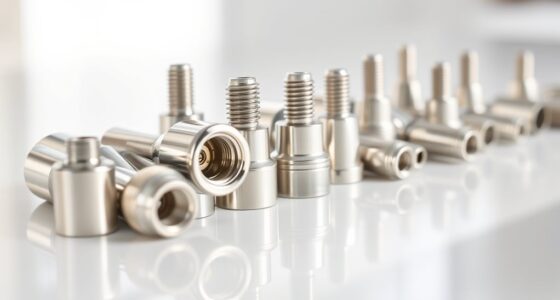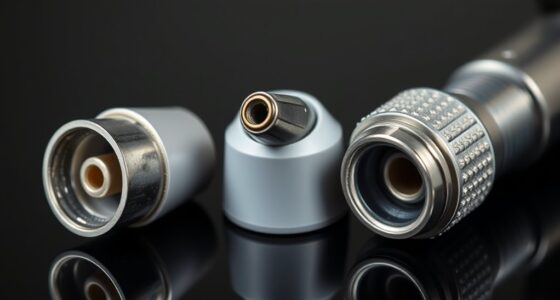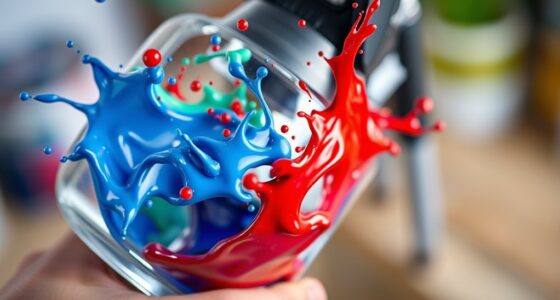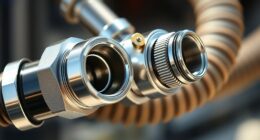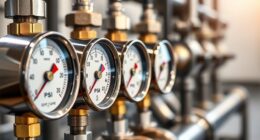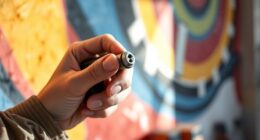When using a paint sprayer, you need to wear protective gear like goggles or safety glasses to shield your eyes from splatters, a respirator mask to prevent inhaling fumes and particles, and gloves to protect your skin from chemicals. Long sleeves, pants, and closed-toe shoes also help reduce overspray contact. Ensuring your safety gear fits well and checking its condition is essential. Keep exploring to learn more about ensuring complete protection during your project.
Key Takeaways
- Wear protective eyewear like goggles or safety glasses to prevent splatters and debris from injuring your eyes.
- Use a respirator mask rated for chemical fumes to filter out harmful fumes and particles.
- Protect your skin with chemical-resistant gloves and long-sleeved clothing to prevent skin contact with paint and solvents.
- Ensure proper ventilation in your workspace to disperse fumes and maintain a safe breathing environment.
- Wear closed-toe footwear and consider ear protection for added safety during extended spraying tasks.

When using a paint sprayer, wearing the right safety gear is vital to protect yourself from harmful fumes, overspray, and debris. Your safety starts with proper eye protection. Protective eyewear, such as goggles or safety glasses, shields your eyes from splatters, dust, and spray particles that can cause irritation or injury. Spray guns often emit fine droplets that can easily get into your eyes, especially if you’re working in a cluttered or windy environment. Investing in quality eye protection ensures you can work confidently without risking damage to your vision.
Wearing proper eye protection is essential when using a paint sprayer to prevent injury from splatters and spray particles.
In addition to eyewear, a respirator mask is indispensable for safeguarding your respiratory system. Paint fumes, solvents, and particles can be hazardous when inhaled, especially during prolonged use or when working in poorly ventilated areas. A properly fitted respirator mask filters out dangerous chemicals, preventing irritation of your lungs, dizziness, or more serious health issues over time. Disposable masks may suffice for quick projects, but for longer jobs or when working with solvent-based paints, a respirator with replaceable filters offers superior protection. Make sure to choose a mask rated for chemical fumes and ensure it fits snugly against your face to prevent leaks.
Beyond eye and respiratory protection, consider wearing gloves to shield your skin from paint and solvents. Chemical-resistant gloves prevent skin absorption of harmful substances and make cleanup easier. Long-sleeved shirts and pants further protect your arms and legs from overspray. A hat or head covering can keep paint out of your hair and reduce the risk of splatters on your scalp.
When preparing your workspace, don’t forget about your footwear. Closed-toe shoes or boots guard your feet from accidental spills or drips. If you’re working outdoors, a hat and possibly ear protection can enhance your comfort and safety. Always check your safety gear before starting; ensure that goggles are clear, masks fit properly, and gloves are intact. Properly fitted safety gear is not just about compliance, but about genuinely reducing your risk of injury or health problems.
Additionally, being aware of ventilation requirements is crucial to ensure that fumes are effectively dispersed and you remain safe throughout your project.
Frequently Asked Questions
Can I Use a Paint Sprayer Without Safety Gear?
You shouldn’t use a paint sprayer without safety gear because paint splatter can cause skin and eye irritation. Wearing goggles, gloves, and a mask helps protect you from harmful fumes and accidental splashes. Always follow proper equipment maintenance to guarantee safe operation. Skipping safety gear increases your risk of injury and exposure to chemicals, so it’s essential to prioritize safety every time you use a paint sprayer.
What Is the Most Essential Safety Equipment for Beginners?
Many believe that beginners only need minimal safety gear, but research shows that proper protection is vital for safe paint spray techniques. You should always wear a respirator to prevent inhaling harmful fumes, goggles to shield your eyes from overspray, and gloves for skin protection. Environmental safety considerations also mean using masks and proper ventilation. Prioritize these safety items to protect yourself and ensure a successful, safe painting experience.
Are Respiratory Masks Necessary for All Types of Paint?
You should wear a respiratory mask whenever you’re working with paint, as paint fumes can be harmful. Not all masks offer the same protection, so choose one with proper mask filtration to guard against volatile organic compounds and other airborne particles. Even if you’re using low-VOC paints, it’s better to be safe. Always assess the type of paint and fumes you’re dealing with to determine if a mask is necessary.
How Do I Choose the Right Gloves for Paint Spraying?
When choosing gloves for paint spraying, consider the glove material, such as nitrile or latex, which offers good chemical resistance. Make sure the gloves fit well and feel comfortable, so they don’t hinder your dexterity or cause fatigue. Opt for gloves that provide a snug fit but aren’t too tight, ensuring protection without sacrificing comfort. Proper gloves keep your skin safe from paint and chemicals during the spraying process.
Is Eye Protection Mandatory When Cleaning the Sprayer?
In the days of knights and dragons, safety was paramount, and today, eye safety remains vital. When cleaning your paint sprayer, protective eyewear isn’t just recommended; it’s mandatory. Splashing paint or solvents can cause serious eye injuries. Wearing protective eyewear shields your eyes from harmful chemicals and debris. Always prioritize eye safety to prevent accidents, and remember, a simple pair of safety goggles can save you from costly and painful accidents.
Conclusion
Remember, wearing the right safety gear isn’t just a good idea—it’s essential. About 60% of paint-related injuries happen due to inadequate protection, so don’t take chances. By donning your mask, goggles, gloves, and a protective suit, you greatly reduce your risk of inhaling fumes or getting splattered. Stay safe and protect yourself properly; it’s the best way to enjoy your painting project without unnecessary accidents or health issues.
Franz came aboard the Paint Sprayer Zone team with a background in both journalism and home renovation. His articulate writing style, combined with a passion for DIY projects, makes him an invaluable asset. Franz has a knack for breaking down technical jargon into easy-to-understand content, ensuring that even the most novice of readers can grasp the complexities of paint sprayers.
